Components
- Arduino MKRFox1200
- Sigfox Antenna
- Micro USB to USB
Setup Your Environment
If you have not already done, download and install the Arduino IDE for your chosen operating system here.
- Open the IDE and go to
Tools > Boards > Board Manager - Search for the
Arduino SAMD Boards - Install the board's core library
Connect the Board to your Computer
Using a micro USB cable, connect the micro USB port on the board to the USB port on your computer.
Install required Libraries
- Go to
Sketch > Include Libraries > Manage Libraries - Type
SigFoxinto the search bar and click the first option. A button will appear in the bottom right of the box that will allow you to install the library
Repeat install for libraries:
- Arduino Low Power
- RTCzero
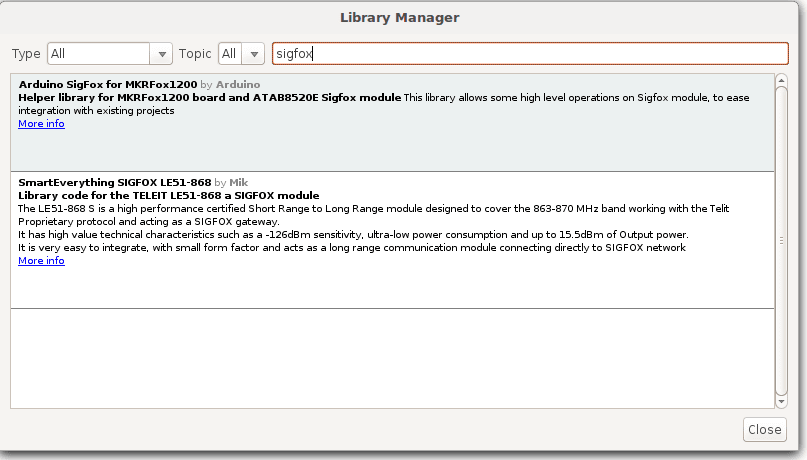 Sigfox Library
Sigfox Library
Select Board and Port
Once you've got it connected to your computer, in the Arduino IDE, Select Tools
- Select the
Arduino MRKFox1200board - Select the correct port (Arduino MRKfox1200 should be on the port name): If no name is displayed, you can find the port with the following steps:
Linux and Mac OS X
- Download and install the FTDI drivers from here. Select the appropriate version for your operating system and architecture
- Open a terminal window and run the command
ls /dev/tty* - Look for a device with the name that begins with
/dev/ttye.g./dev/tty.usbmodemPy343431on MAC or/dev/ttyUSB0/dev/ttyACM0on Linux
Note: For Linux, you may need to run the two commands below. Once you've completed that, reboot your computer. This will add permissions that will allow you to upload a sketch to the board.
sudo usermod -a -G tty ${USER}
sudo usermod -a -G dialout ${USER}
Windows
- Download and install the FTDI drivers from here. Select the appropriate version for your operating system and architecture
- Open the Windows start menu and search for
Device Manager - The COM port for the Pycom device will be listed as
USB Serial Deviceor something similar - Keep note of the COM port (e.g. COM4)
Install the required libraries
Create a new Sketch
Create a new file called sketch_sigfox_init.ino and add the code below.
sketch_main.ino
#include <SigFox.h> // must include the SigFox library
void setup() {
Serial.begin(9600);
while(!Serial) {}; //waits for Serial to be available
if (!SigFox.begin()) { //ensures SigFox is connected
Serial.println("Shield error or not present!");
return;
}
String version = SigFox.SigVersion();
String ID = SigFox.ID();
String PAC = SigFox.PAC();
Serial.println("ID = " + ID);
Serial.println("PAC = " + PAC);
delay(100);
// Send the module to the deepest sleep
SigFox.end();
}
void loop() {
}
The code above just waits until the Serial has begun. This makes sure Sigfox is connected and prints the Device ID and PAC number of the Device.
Upload Code to the Board
Click Sketch > Upload to upload the code to your Device to retrieve the ID and PAC number of the device.
View the Serial Monitor
- Click the
Screen Monitoricon on the right hand side - In the monitor, it should display the ID and PAC for the device
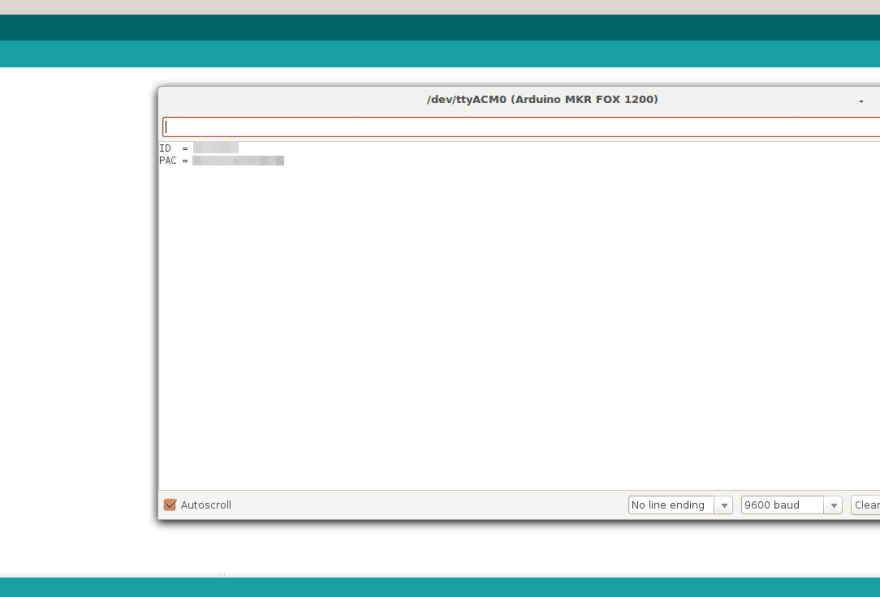 Board ID and Pac Numbers
Board ID and Pac Numbers
Register Device with Sigfox
- Click here to register the Device with Sigfox
- Choose the provider Arduino from the list Then, choose the appropriate country
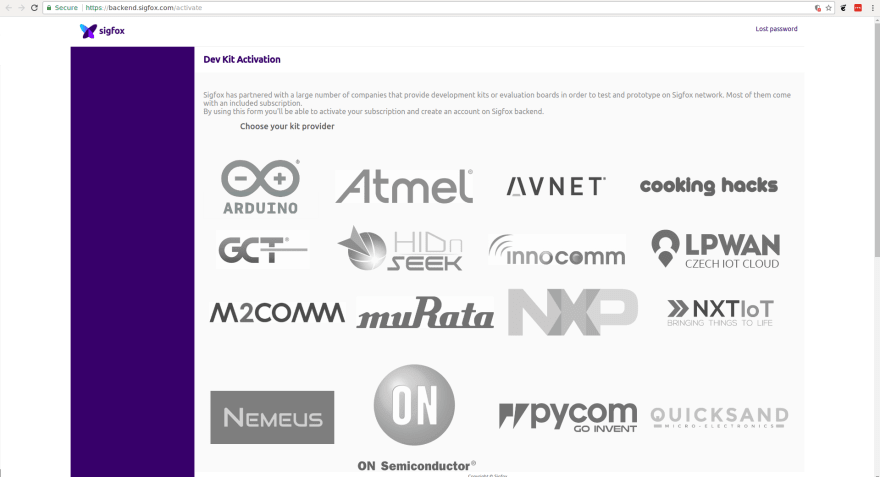 Sigfox providers
Sigfox providers
Enter Device information
- Enter the ID and PAC of your device into Sigfox
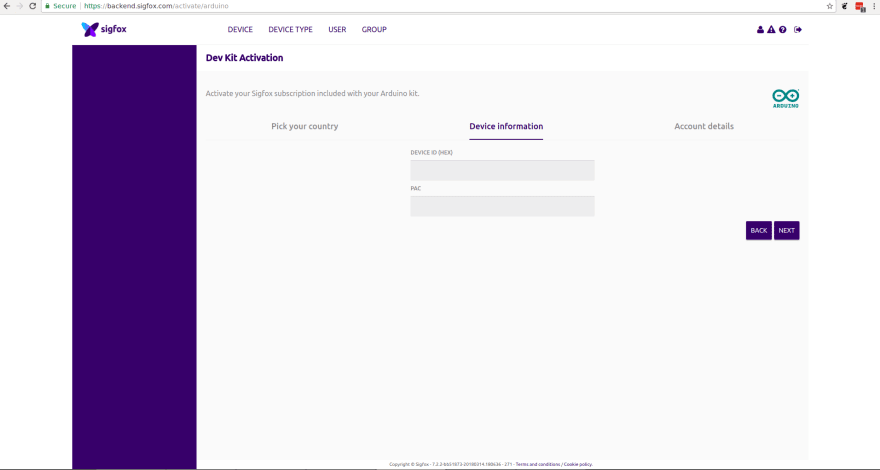 Sigfox Device ID and PAC
Sigfox Device ID and PAC
Once entered, you must sign in or sign up to a Sigfox account to view your Device on the Sigfox Dashboard.
The Code
Create a new file called sketch_sigfox.ino and add the code below.Make sure that:
- Tools > Boards is set to Arduino MRKfox1200
- Tools > Port is set to the port of the board
Sigfox
#include <SigFox.h> // must include the SigFox library
void setup() {
Serial.begin(9600);
while(!Serial) {}; //waits for Serial to be available
if (!SigFox.begin()) { //ensures SigFox is connected
Serial.println("Shield error or not present!");
return;
}
Serial.print("sending");
Serial.print(SigFox.internalTemperature())
SigFox.begin();
SigFox.beginPacket();
SigFox.print(SigFox.internalTemperature()); //content of the packet
SigFox.endPacket();
Serial.print("sent");
}
void loop() {
while(1);
}
-
SigFox.beginPacket()&SigFox.endPacket()are the wrappers for the payload - The data is placed between the wrappers and has a max size of
12 Bytes - Strings will be converted to hexadecimal
Upload the Code
- Click Sketch > Upload to upload the code for MRKfox1200
- You can view the output from the serial monitor on the right of the screen
Receiving the Message on Sigfox dashboard
- Go to the Sigfox dashboard, the link is here
On your Sigfox account, click on the
Devicetab, click on yourDevice IDand clickMessages

Sigfox messageThe payload will be displayed in hexadecimal
Convert to ASCII to view your message
Connecting Sigfox with Wia
- First, Sigfox must be integrated with Wia to see your Sigfox messages in Wia
- The tutorial can be accessed here
Receiving the message on Wia
If the callback has been properly setup between Sigfox and Wia, the message should also be displayed in Wia
- Go to your Space that has your Sigfox integration
- Click on Device that matches the Sigfox device on the Sigfox website
- Click on the events tab and Sigfox message should be displayed
If you need any help with getting setup or you don't understand the tutorial, tweet us, email support@wia.io or chat on Intercom.

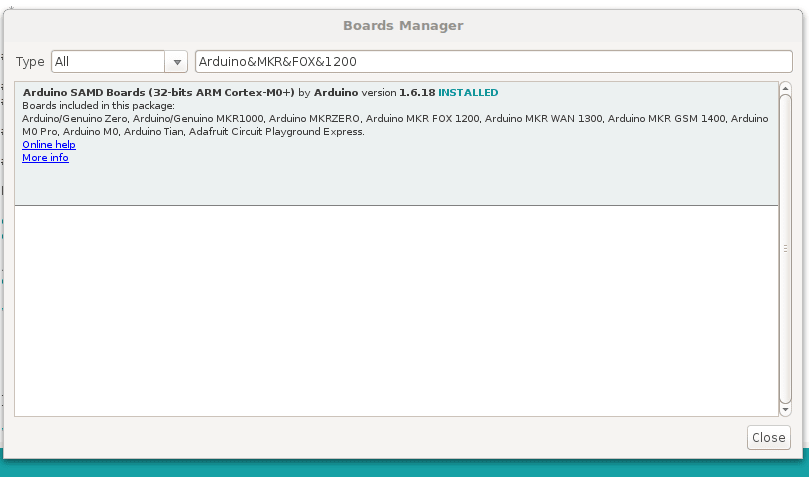
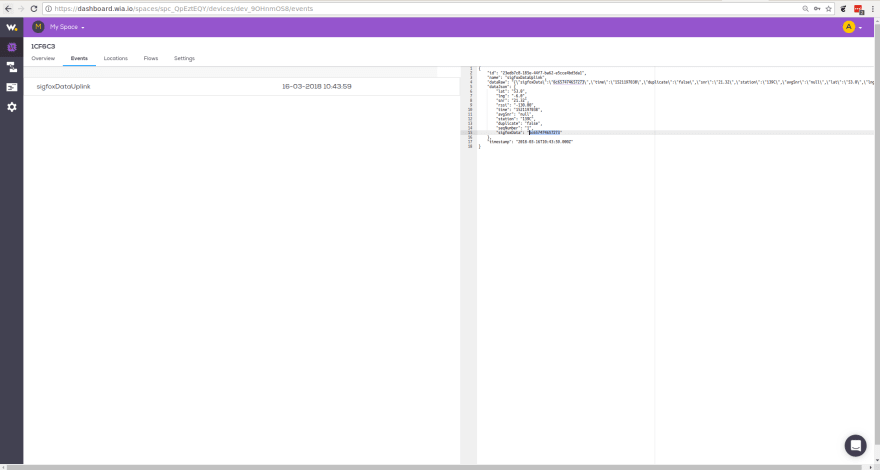

Top comments (0)